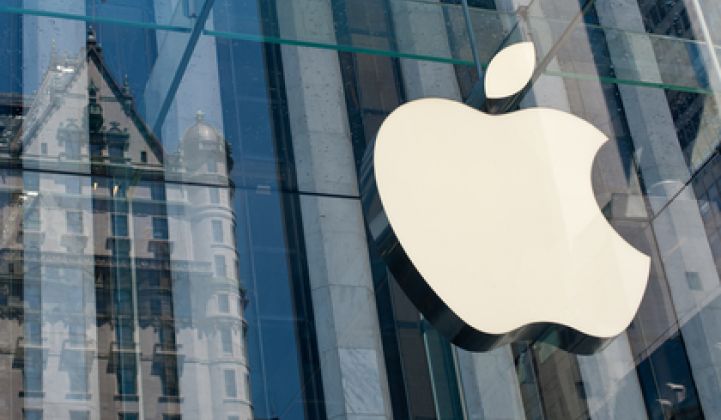In March, Apple CEO Tim Cook made a bold proclamation to shareholders: If you don't like the company's environmental strategy, drop the stock.
During an investor meeting, a lawyer with the National Center for Public Policy Research, a conservative think tank skeptical of climate change, continued to challenge Cook about his company's environmental initiatives. Finally, after three questions, Cook responded.
"We do things because they are right and just and that is who we are. [...] I don’t think about helping our environment from an ROI point of view," he shot back, receiving applause for the response.
Although investing in renewables and lowering resource consumption actually does have a strong return on investment, Cook made a valuable point. Apple seems sincere in its efforts to lower its carbon emissions and energy footprint, and it's willing to stick to a long-term plan rather than just worry about satisfying the quarterly demands of investors. The hiring of former EPA Administrator Lisa Jackson to lead environmental initiatives was another signal of Apple's seriousness.
And on the whole, it appears investors are following along -- even demanding Apple step up its efforts in the area.
Apple has been widely criticized for its failure to report emissions to the Carbon Disclosure Project (CDP), an international nonprofit that tracks environmental performance for the largest investors in the world. But that has finally changed.
Upon releasing its latest sustainability report this week, Apple also said it would start supplying its emissions data to CDP. It attributed the change in policy to shareholder demand for clearer data.
"We heard from some shareholders that making this information available through the CDP would help them more easily track our environmental performance," wrote the company in a statement.
So how is Apple actually doing in this area?
The company is out with new data on renewable energy procurement, data center operations, water and materials use, and retail operations for 2013. Below are some strongest indicators of Apple's improving performance.
For a spirited conversation on how large corporations are faring in their environmental efforts, listen this recent episode of The Energy Gang:
3 Percent
Apple reported a 3 percent reduction in carbon emissions last year. After changing its reporting methodology, the company found that its manufacturing facilities were spewing far more emissions than previously believed. Once the new calculations were completed, the company posted a 9 percent increase over 2012. However, after recalculating the 2012 numbers based on the improved methodology, the final outcome was a modest 3 percent drop.
20 Percent
That's how much water Apple saved at its state-of-the-art data center in Maiden, North Carolina by using a cooling system that reuses water 35 times throughout the facility. At campus facilities, Apple has achieved a 40 percent reduction in water used for landscaping. It also started implementing a company-wide conservation and recycling program. However, those efforts were no match for Apple's expansion plans, which boosted water consumption per employee by 9 cubic meters due to construction of a new campus.
30 Percent
Through various building efficiency efforts in new and existing facilities, which Eric Wesoff described last year, Apple reported a consistent 30 percent drop in energy use across its data centers, office buildings and in retail stores. While employee count continues to grow, energy use continues to fall.
57 Percent
Over the last six years, Apple has cut the average power consumption from its products by 57 percent. The company has taken a three-pronged approach to improving device energy performance by focusing on power supply, hardware efficiency and power management software. Apple has also reported that its desktop iMacs use 97 percent less electricity in sleep mode than did the first generation of iMacs in 1998.
100 Percent
Apple is now reporting that all of its data centers are supplied by 100 percent renewable electricity. That includes on-site solar and biogas fuel cells, plus power-purchase agreements for off-site geothermal, wind and solar projects.
169 Percent
Over 2013, Apple increased its procurement of renewables by 169 percent. Much of those renewables went toward powering data centers. The company's next goal will be to fully power corporate buildings and retail stores with on-site renewables or electricity delivery contracts.
400
That's how many retail stores Apple has opened up around the globe. The company has only been able to go fully renewable at 160 stores, but it still has far more to work to do to cover the remaining outlets.
10,000
Last year, 10,000 employees took advantage of Apple's subsidy for carpooling and public transit each month. That program, along with providing bike sharing, biofuel-powered coach buses and electric-car charging stations, helped reduce employee transportation emissions by 59 percent compared to 2012.
In recent years, Apple has fallen way down on lists ranking corporate environmental strategies, mostly for its failure to release carbon data to the CDP. But this new data shows strong progress at the company, which will likely boost its profile among top companies.



